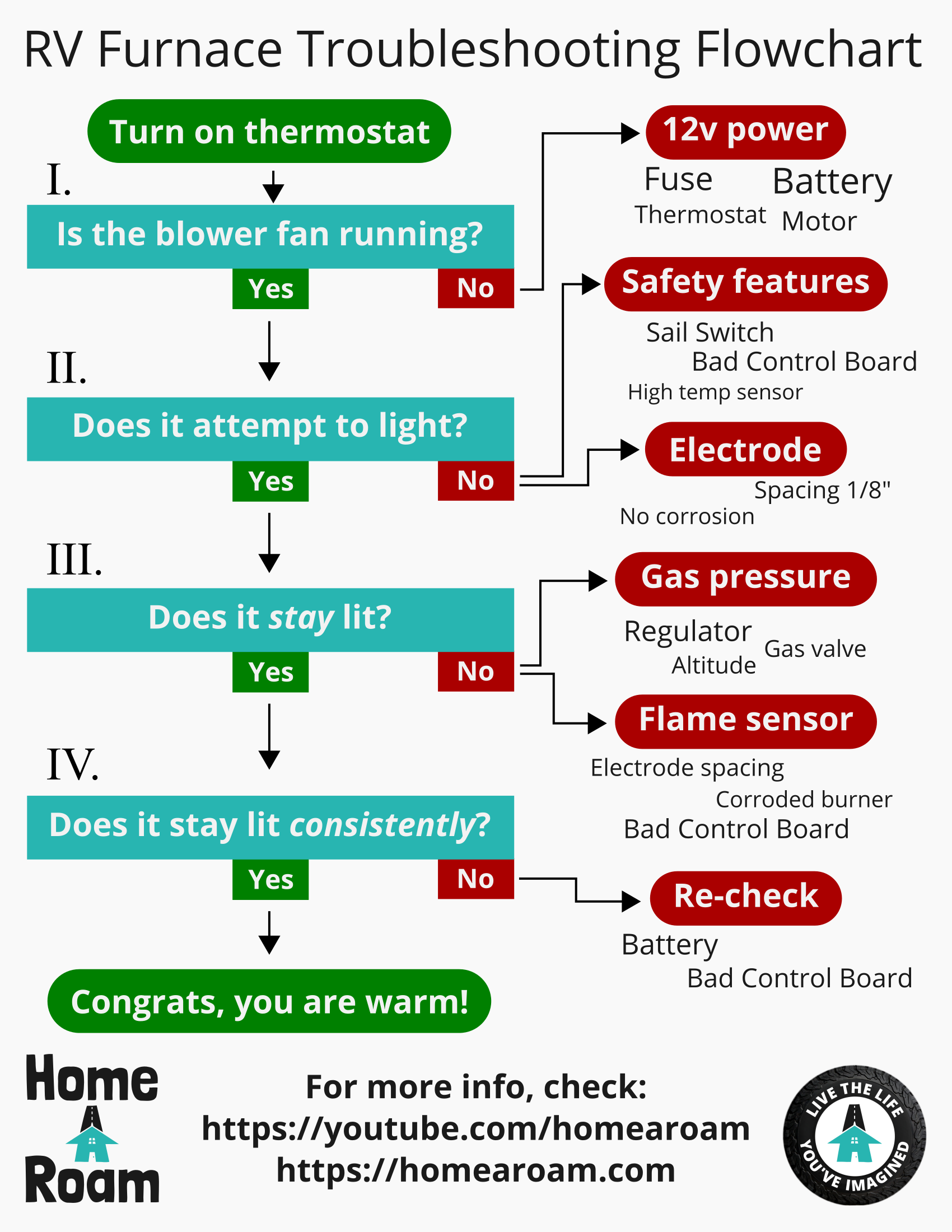RV Furnace Repair and Troubleshooting Guide
Do you have an RV furnace that is blowing cold air, won't ignite, won't turn on, or won't stay lit?
Trust us, we've been there. And we've created a step-by-step troubleshooting flowchart to help you solve your maintenance issues and repair your RV furnace!
Watch our full video that explains all of the steps to troubleshoot your RV furnace problems in depth!
And check out the flowchart below.
How to troubleshoot RV furnace problems
So you’re having some trouble with your RV furnace, eh? No worries, we’re here to help.
The first thing you need to do is switch on your thermostat.
Stage 1: Is the blower fan running?
If it is, that’s great! Continue to Stage 2. If your blower fan isn’t coming on though, it’s likely because it’s not getting 12-volt power. The first thing to check is the fuse. Sometimes a surge can blow them, so always make sure you carry a few spares of each size your fuse panel takes.
If your fuse is good, time to check the battery. If it’s really cold out, your battery performance can decrease significantly, and there won’t be enough power to turn on the blower motor. Check your battery voltage, and if it reads low, try connecting to shore power, or using a generator.
Failing those two things, you may have an actual hardware problem with your thermostat or furnace motor, and you are probably better off calling a professional.
Stage 2: Does it attempt to light?
Is your motor on, but simply blowing cold air? And your RV furnace doesn’t appear to be trying to light up?
This is very likely due to one of the safety features of your furnace. One that oftens goes bad is called the “sail switch”. This is a switch that gets activated by the air current generated by your blower fan. It can sometimes get dust, dirt, or pet hair that blocks it from pressing down. And if it doesn’t press down, the furnace thinks the fan has failed, and won’t try to light the flame.
If your sail switch looks good, your furnace control board could be suspect. Moisture in the air, or condensed and accumulated on the board can short it out and cause it to malfunction. These boards are fragile, and full-timers who travel in the winter will often carry a spare one along with them. They are not cheap (about $100 USD at the time of writing) but it’s worth trying this since it’s a very common cause of failure.
It could also be your high temperature sensor. This is a probe that checks if the flame temperature has exceeded a certain threshold. If it’s reporting a bad value, the furnace will think it has overheated and cut the gas supply.
Stage 3: Does it stay lit?
Is your RV furnace lighting briefly, but then almost immediately going out? There are two factors that can cause this behavior.
First, check your gas pressure. Turn on all of your stove burners. Are the flames strong and blue in color? If the flame is weak and/or yellow in color, your gas pressure may be too low. Check your propane levels and try with a completely full tank.
If you still have problems with a full propane tank, it may be your regulator. If your regulator is more than 5 years old, it may be worth installing a new one as they are fairly inexpensive and critical to the operation of many appliances in your RV.
Another factor is altitude. Some RV furnaces have trouble running at high altitude. Unfortunately the only solution in this case is to return to a lower altitude and look into furnace replacements that perform better at high altitudes.
The final component to check is the “flame sensor”. This is a probe that generates an electrical current when exposed to an open flame. It’s critical that the spacing is correct and that it’s free of corrosion.
Note that you must disconnect your propane gas line to inspect this component, so it may be better left to a professional.
Finally, as mentioned earlier, your control board may have gone bad. Sometimes all of the correct signals are being sent to an RV furnace control board, but it will interpret them wrong and shut off the gas as a safety feature.
Often purchasing and installing a new control board can solve these types of problems.
Stage 4: Does it stay lit consistently?
Does your RV furnace light, run for a while, and then quit at random intervals? If so, don’t ignore these signs. It could be the precursor to an imminent failure that could be more permanent.
Check your battery, propane pressure and regulator, and if the intermittent problems continue, consider replacing your control board.
If your furnace does stay lit consistently, then congratulations! You now have a working RV furnace and you’ll be staying warm!





